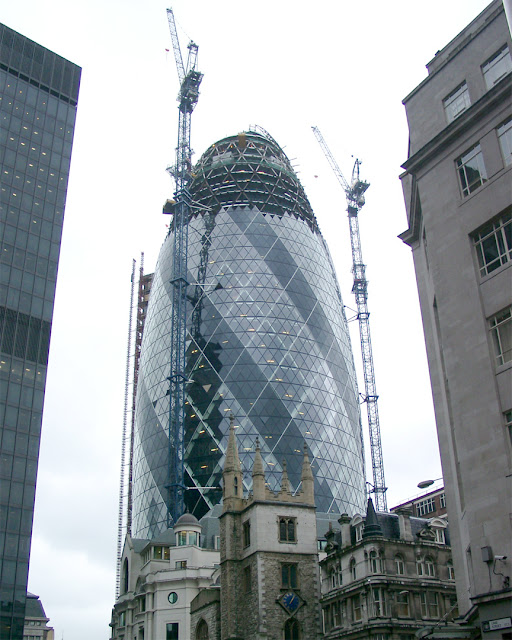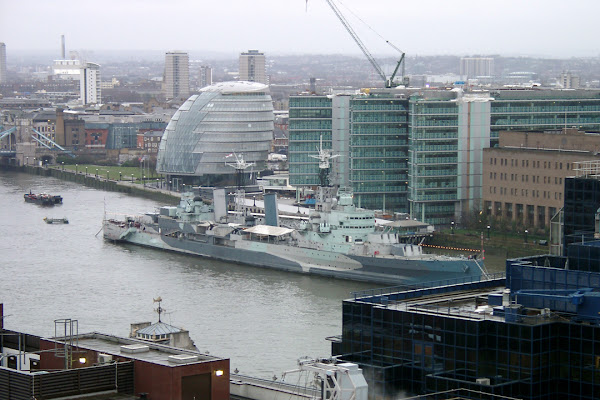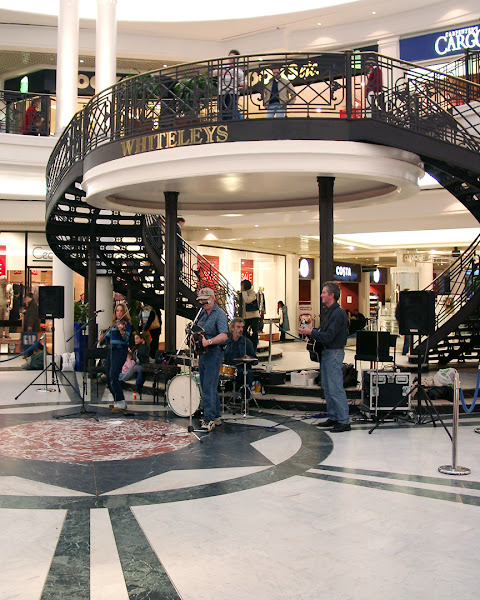Monday, May 31, 2004
St Andrew Undershaft
St Andrew Undershaft
St Mary Axe
London, January 2003
“St Andrew Undershaft is a Church of England church in the City of London, the historic nucleus and modern financial centre of London. It is located on St Mary Axe, within the Aldgate ward, and is a rare example of a City church that survived both the Great Fire of London and the Blitz. The present building was constructed in 1532 but a church has existed on the site since the 12th century. Today, St Andrew Undershaft is administered from the nearby St Helen's Bishopsgate church.” (St Andrew Undershaft, Wikipedia)
Sunday, May 30, 2004
Lloyd's building
Lloyd's building by Richard Rogers and Partners, 1986
Lime Street, City of London
London, January 2003
“The Lloyd's building (sometimes known as the Inside-Out Building) is the home of the insurance institution Lloyd's of London. It is located on the former site of East India House in Lime Street, in London's main financial district, the City of London. The building is a leading example of radical Bowellism architecture in which the services for the building, such as ducts and lifts, are located on the exterior to maximise space in the interior. In 2011, twenty-five years after its completion in 1986 the building received Grade I listing; at this time it was the youngest structure ever to obtain this status. It is said by Historic England to be ‘universally recognised as one of the key buildings of the modern epoch’.” (Lloyd's building, Wikipedia)
Saturday, May 29, 2004
Friday, May 28, 2004
Thursday, May 27, 2004
External lifts
External lifts
Lloyd's building by Richard Rogers and Partners, 1986
Lime Street, City of London
London, January 2003
“The current Lloyd's building (address 1 Lime Street) was designed by the architect company Richard Rogers and Partners (now Rogers Stirk Harbour + Partners) and built between 1978 and 1986. Bovis was the management contractor. Like the Pompidou Centre in Paris (designed by Renzo Piano and Rogers), the building was innovative in having its services such as staircases, lifts, ductwork, electrical power conduits and water pipes on the outside, leaving an uncluttered space inside. The 12 glass lifts were the first of their kind in the United Kingdom. Like the Pompidou Centre, the building was highly influenced by the work of Archigram in the 1950s and 1960s.” (Lloyd's building, Wikipedia)
Wednesday, May 26, 2004
HMS Belfast
HMS Belfast
The Queen's Walk
London, January 2003
“HMS Belfast is a Town-class light cruiser that was built for the Royal Navy. She is now permanently moored as a museum ship on the River Thames in London and is operated by the Imperial War Museum. Construction of Belfast, the first ship in the Royal Navy to be named after the capital city of Northern Ireland and one of ten Town-class cruisers, began in December 1936. She was launched on St Patrick's Day 1938. Commissioned in early August 1939 shortly before the outbreak of the Second World War, Belfast was initially part of the British naval blockade against Germany. In November 1939, Belfast struck a German mine and, in spite of fears that she would be scrapped, spent more than two years undergoing extensive repairs. Belfast returned to action in November 1942 with improved firepower, radar equipment, and armour. Belfast saw action escorting Arctic convoys to the Soviet Union during 1943 and in December 1943 played an important role in the Battle of North Cape, assisting in the destruction of the German warship Scharnhorst. In June 1944, Belfast took part in Operation Overlord supporting the Normandy landings. In June 1945, she was redeployed to the Far East to join the British Pacific Fleet, arriving shortly before the end of the Second World War. Belfast saw further combat action in 1950–52 during the Korean War and underwent an extensive modernisation between 1956 and 1959. A number of further overseas commissions followed before she entered reserve in 1963.” (HMS Belfast, Wikipedia)
Tuesday, May 25, 2004
St Margaret Pattens
St Margaret Pattens
Rood Lane, Eastcheap
Billingsgate, City of London
London, January 2003
“The church was first recorded in 1067, at which time the church was probably built from wood. It was rebuilt in stone at some unknown subsequent date but fell into disrepair and had to be demolished in 1530. It was rebuilt in 1538 but was destroyed in the Great Fire of London in 1666. The present church was built by Sir Christopher Wren in 1687. It is one of only a few City churches to have escaped significant damage in the Second World War. In 1954 St Margaret Pattens ceased to be a parish church and became one of the City’s guild churches, within the living of the Lord Chancellor and under the jurisdiction of the Bishop of London. They have a regular weekday, rather than Sunday congregation, drawn mostly from people who work in offices nearby. The tower accommodates the office of the Archdeacon of Hackney.” (St Margaret Pattens, Wikipedia)
Monday, May 24, 2004
Sunday, May 23, 2004
Saturday, May 22, 2004
Friday, May 21, 2004
Thursday, May 20, 2004
City Hall & More London
City Hall, More London Riverside, More London Place by Foster and Partners
The Queen's Walk
South Bank, Southwark
London, January 2003
Wednesday, May 19, 2004
Tuesday, May 18, 2004
Monday, May 17, 2004
The twin locks
The twin locks on the Regent's Canal
Camden Lock
Camden Town, Camden
London, January 2003
“Camden Lock is a small part of Camden Town, London Borough of Camden, England, which was formerly a wharf with stables on the Regent's Canal. It is immediately to the north of Hampstead Road Locks, a twin manually operated lock. The twin locks together are ‘Hampstead Road Lock 1’; each bears a sign so marked. Hawley Lock and Kentish Town Lock are a short distance away to the east; to the west is a long level pound (also known as tract or reach) — it is 27 miles (43 km) to the next lock.” (Camden Lock, Wikipedia)
Sunday, May 16, 2004
York Water Gate
York Water Gate
Victoria Embankment Gardens
Villiers Street, Charing Cross
London, January 2003
“The mansions facing in the Strand were built there partly because they had direct access from their rear gardens to the River Thames, then a much-used transport artery. The surviving York Watergate (also known as Buckingham Watergate), built by George Villiers, 1st Duke of Buckingham in about 1626 as a ceremonial landing stage on the river, is now marooned 150 yards (137 m) from the river, within the Embankment Gardens, due to substantial riverside land reclamation following the construction of the Thames Embankment. With the Banqueting House it is one of the few surviving reminders in London of the Italianate court style of King Charles I. Its rusticated design in a Serlian manner has been attributed to Sir Balthazar Gerbier, to Inigo Jones himself and to the sculptor and master-mason Nicholas Stone. The design is modelled closely on that of the Medici Fountain in the Jardin du Luxembourg in Paris. It was restored in the 1950s.” (York House, Wikipedia)
Saturday, May 15, 2004
Friday, May 14, 2004
Thursday, May 13, 2004
Overhead footbridge
Overhead footbridge
Villiers Street, Charing Cross
London, January 2003
“The footbridge pictured above stretches over Villiers Street between Embankment and Strand. It was built in 1878 to join the extension of the Charing Cross Hotel (now the Amba Hotel Charing Cross) on the eastern side of Villiers Street to the original building on the western side, but there's little information available about the bridge today. From the outside, it's not even clear whether the hotel still owns the extension on the other side of the street. The bridge exterior is decorated in the same manner as the hotel's conservatory-style restaurant which can be seen from Strand, but lacking any other evidence, we did the only sensible thing and went into the hotel for a nose around. We're pleased to confirm that the bridge is indeed still functioning.” (Where Do London's Mysterious Overhead Footbridges Go?, Londonist)
Wednesday, May 12, 2004
Tuesday, May 11, 2004
A Conversation with Oscar Wilde
“A conversation with Oscar Wilde” by Maggi Hambling, 1998
Adelaide Street
London, January 2003
“A Conversation with Oscar Wilde is an outdoor sculpture by Maggi Hambling in central London dedicated to Oscar Wilde. Unveiled in 1998, it takes the form of a bench-like green granite sarcophagus, with a bust of Wilde emerging from the upper end, with a hand clasping a cigarette.” (A Conversation with Oscar Wilde, Wikipedia)
Monday, May 10, 2004
Waterloo Bridge
Waterloo Bridge with the City in background
Seen from Victoria Embankment
London, January 2003
“Waterloo Bridge is a road and foot traffic bridge crossing the River Thames in London, between Blackfriars Bridge and Hungerford Bridge. Its name commemorates the victory of the British, Dutch and Prussians at the Battle of Waterloo in 1815. Thanks to its location at a strategic bend in the river, the views from the bridge (of Westminster, the South Bank and the London Eye to the west, and of the City of London and Canary Wharf to the east) are widely held to be the finest from any spot in London at ground level.” (Waterloo Bridge, Wikipedia)
Sunday, May 9, 2004
Saturday, May 8, 2004
National Firefighters Memorial
National Firefighters Memorial by John W. Mills, 1991
Carter Lane Gardens
St. Paul's Churchyard
London, January 2003
“The National Firefighters Memorial is a memorial composed of three bronze statues depicting firefighters in action at the height of the Blitz. It is located on the Jubilee Walkway to the south of St Paul's Cathedral in the City of London, and it is approachable from the south bank of the River Thames via the Millennium Footbridge. The monument, originally the concept of Cyril Demarne, was commissioned by the Firefighters Memorial Charitable Trust set up in 1990. It was sculpted by John W. Mills. Initially, the structure was intended as a tribute to those men and women who fought so gallantly against fire on the streets of London during the Blitz of World War II, when the city was struck by bombs on 57 consecutive nights in a sustained campaign of bombing. It also served as a monument to commemorate the service of firefighters throughout the war. Queen Elizabeth The Queen Mother unveiled the memorial on 4 May 1991. It was decided in 1998 to make the memorial a national monument that would commemorate not just the firefighters who died in World War II, but the lives of all firefighters throughout the United Kingdom who were killed in the line of duty. The National Firefighters Memorial was moved from its original site in Old Change Court, the plinth was elevated by a little over 1 m, and the names of all those killed in peacetime were added.” (National Firefighters Memorial, Wikipedia)
Friday, May 7, 2004
St Paul's Cathedral
St Paul's Cathedral
St Paul's Churchyard
London, January 2003
“St Paul's Cathedral is an Anglican cathedral in London, United Kingdom, which, as the cathedral of the Bishop of London, serves as the mother church of the Diocese of London. It sits on Ludgate Hill at the highest point of the City of London and is a Grade I listed building. Its dedication to Paul the Apostle dates back to the original church on this site, founded in AD 604. The present cathedral, dating from the late 17th century, was designed in the English Baroque style by Sir Christopher Wren. Its construction, completed in Wren's lifetime, was part of a major rebuilding programme in the City after the Great Fire of London. The earlier Gothic cathedral (Old St Paul's Cathedral), largely destroyed in the Great Fire, was a central focus for medieval and early modern London, including Paul's walk and St Paul's Churchyard being the site of St Paul's Cross. The cathedral is one of the most famous and most recognisable sights of London. Its dome, framed by the spires of Wren's City churches, has dominated the skyline for over 300 years. At 365 feet (111 m) high, it was the tallest building in London from 1710 to 1963. The dome remains among the highest in the world. St Paul's is the second-largest church building in area in the United Kingdom after Liverpool Cathedral.” (St Paul's Cathedral, Wikipedia)
Thursday, May 6, 2004
Wednesday, May 5, 2004
Tuesday, May 4, 2004
Monday, May 3, 2004
Dragon at Temple Bar
Dragon boundary mark by C. B. Birch
Fleet Street, Temple Bar
London, January 2003
“The dragon boundary marks are cast iron statues of dragons on metal or stone plinths that mark the boundaries of the City of London. The dragons are painted silver, with details of their wings and tongue picked out in red. The dragon stands on one rear leg, the other lifted against a shield, with the right foreleg raised and the left foreleg holding a shield which bears the City of London's coat of arms, painted in red and white. This stance is the equivalent of the rampant heraldic attitude of the supporters of the City's arms. The design is based on two large dragon sculptures, 7 feet (210 cm) high, which were mounted above the entrance to the Coal Exchange on Lower Thames Street, designed by the City Architect, J. B. Bunning, and made by the London founder Dewer in 1849. The dragons were preserved when the Coal Exchange was demolished in 1962–3. The two original statues were re-erected on 6 feet (180 cm) high plinths of Portland stone at the western boundary of the City, by Temple Gardens on Victoria Embankment, in October 1963. The Corporation of London's Streets Committee selected the statues as the model for boundary markers for the city in 1964, in preference to the fiercer dragon by C. B. Birch at Temple Bar on Fleet Street. There are thirteen Dragons around the City of London. Half-size replicas of the original pair of dragons made by Birmingham Guild Limited were erected at main entrances to the City of London in the late 1960s. In addition to the Birch dragon at Temple Bar, and the two original Coal Exchange statues on Victoria Embankment, there are two replicas of the Coal Exchange dragon at the south end of London Bridge, two on High Holborn near Gray's Inn Road, and single replicas on Aldgate High Street, Bishopsgate, Byward Street, Moorgate, Goswell Road (north of Aldersgate Street), Farringdon Street, and at the south end of Blackfriars Bridge. Outside London, there is also a replica at Lake Havasu City, Arizona, where the 19th century London Bridge was reconstructed in 1971.” (Dragon boundary mark, Wikipedia)
Sunday, May 2, 2004
Royal Courts of Justice Clock
Clock of the Royal Courts of Justice, 1883
Designed by George Edmund Street
Made by Potter & Sons
Strand, City of Westminster
London, January 2003
Saturday, May 1, 2004
Subscribe to:
Posts (Atom)































